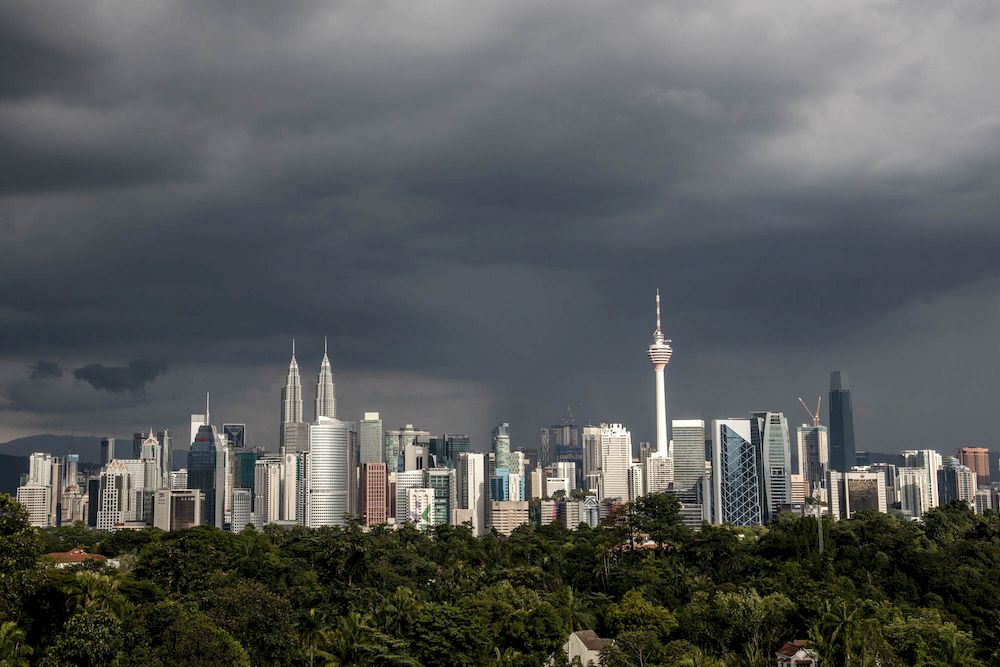A view of the city skyline during monsoon season in Kuala Lumpur on October 21, 2021. — Picture by Firdaus Latif
KUALA LUMPUR, Oct 22 — Malaysia’s real gross domestic product (GDP) growth for 2021 is estimated at 4.0 per cent, below the average 4.9 per cent during the pre-Covid-19 period, but the economy is clearly on the path of a V-shaped recovery, said the Malaysian Institute of Economic Research (MIER).
In its latest Malaysian Economic Outlook, Third Quarter 2021 report, MIER said the estimated GDP is determined based on this year’s macroeconomic performance, unfavourable developments and challenges which have affected the Malaysian economy.
Nevertheless, real GDP growth is expected to pick up strongly to record between 5.5 per cent and 6.5 per cent in 2022, indicating that all resources are likely to be fully utilised, especially towards the latter part of next year.
V-shaped recovery
MIER said there are clear signs of V-shaped recovery, especially with expanding aggregate domestic demand, comprising both private consumption and investment, continuing strong growth in net exports of goods and services, increasing net international reserves of Bank Negara Malaysia (BNM), and increasing inflows of both direct and portfolio investments by foreign investors.
It said that private consumption and private investment are expected to continue gaining momentum in the coming quarters as a result of the planned reopening of the economy in the fourth quarter of 2021 and rising imports of both intermediate and capital goods.
“However, lagging indicators need to be closely monitored, especially with the rising number of non-performing loans (NPLs), slowing vacancies and job placement rates, rising property market overhang, and weaknesses in financial market conditions,” said MIER, which is an independent, non-profit organisation.
It said Malaysia is experiencing the so-called commodity-currency shocks as prices of commodity exports are surging, while the ringgit exchange rate, as measured by the nominal effective exchange rate (NEER), remains weak.
“Consequently, macro weaknesses are expected to persist and it includes continuing net outflows of portfolio and other investments by residents, rising cost of living, elevated public sector and household debts, and increased likelihood of further downgrading of ratings for Malaysia’s sovereign debt,” it said.
Fiscal deficit forecast to widen
The fiscal deficit of the federal government’s financial position is projected to widen further as it moves closer to 6.0 per cent of nominal GDP in 2021 despite expected improvement in the overall economy this year.
It is still below the highest ratio of 6.5 per cent of GDP, recorded in 2009 when the country was hit hard by the global economic and financial crisis, said MEIR.
As at end-June 2021, total outstanding federal government debt continues to accumulate, totalling RM958.4 billion, an equivalent of 61.1 per cent of GDP, well above the current statutory debt-to-GDP limit of 60 per cent.
“Moving forward, consumption-based taxes, previously known as the Goods and Services Tax (GST), could be reimplemented with fine-tuning measures to ensure its effectiveness as an automatic built-in stabiliser.
“Raising income tax rates for both individuals and corporates seems to be unfair in the current difficult environment. Moreover, the share of direct taxes to total revenue should be on the declining path over the long haul,” it said.
Tilt monetary policy to avoid imbalance
In view of an expected economic recovery process and higher interest rates abroad, MIER said BNM’s monetary policy should tilt moderately toward a less accommodative stance, as well as inflation expectations need to be systematically and analytically measured to avoid financial imbalances.
A hike in the United States interest rates later this year or early 2022 could possibly see contagion in monetary policy actions, pushing interest rates higher on the international front, it said.
“If Malaysia remains behind the curve, there will be continued market pressures on the ringgit exchange rate and potentially large reserve losses or sharp ringgit depreciation,” it said.
According to MIER, changes in the overnight policy rate (OPR) need to be gradual and must be spread out over time, while other key macro variables need to be considered in the monetary policy reaction function, especially changes in exchange rates and movements in key asset prices, such as equity and house prices.
“A good signalling mechanism or “forward guidance” must be applied to inform and educate economic agents and stakeholders at large that interest rate hike is also influenced by monetary policy contagion,” it said.
IMF revises 2021 world economy growth
In its latest World Economic Outlook report, the International Monetary Fund (IMF) has downgraded the 2021 annual growth estimate for the world economy at 5.9 per cent, 0.1 percentage points lower from July’s update of 6.0 per cent.
The report said near-term divergent recoveries are projected for the world economy with shocks from the Covid-19 pandemic expected to last longer, affecting medium term performance.
Following the surge in commodity prices, prospects for Emerging Market and Developing Economies (EMEs) have been revised upwards for 2021, while the growth forecast for Advanced Economies is revised downwards with even larger percentage points, on account of supply disruptions.
In the medium term, global growth is expected to moderate back to about 3.3 per cent per annum.
However, the IMF maintained a global growth forecast for 2022 at 4.9 per cent, indicating that global recovery would continue next year. — Bernama

